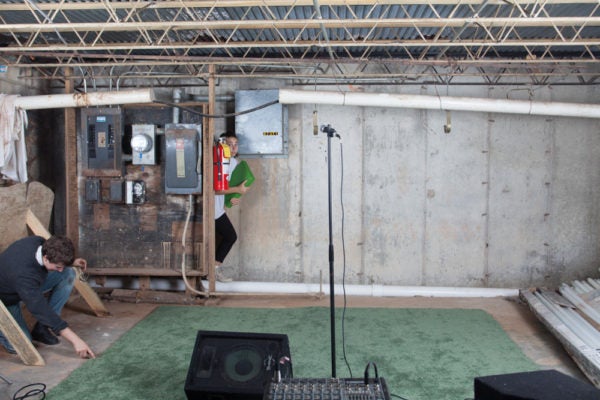
All photos courtesy of Blair LeBlanc and Mo Costello / The Zero.
The paths of Georgia-based artists Blair LeBlanc and Mo Costello initially crossed over email after curator Daniel Fuller of Atlanta Contemporary suggested LeBlanc as a contributor for Costello’s curatorial project Picture Newspaper, in collaboration with publisher Marcelo Gabriel Yáñez. So began a gleeful and determined friendship—characterized by ardent exchange, openness, and a beckoning, challenging sense of invitation—which eventually catalyzed a series of events that led to the establishment of the alternative school The Zero on Broad Street in Downtown Atlanta.
I met Costello and LeBlanc at the Majestic Diner to talk about their shared endeavor. During our conversation, they presented me with “offerings and artifacts” including a ziplock bag containing a shot of whiskey, a blow-up print of a single page of writings by Hélène Cixous, a manila folder containing the entire Cixous essay from which the print displays an excerpt, a flyer for the fall semester at The Zero, and a photograph of Atlanta grindcore musician Debra Beat dressed up as Judas Priest vocalist Rob Halford.
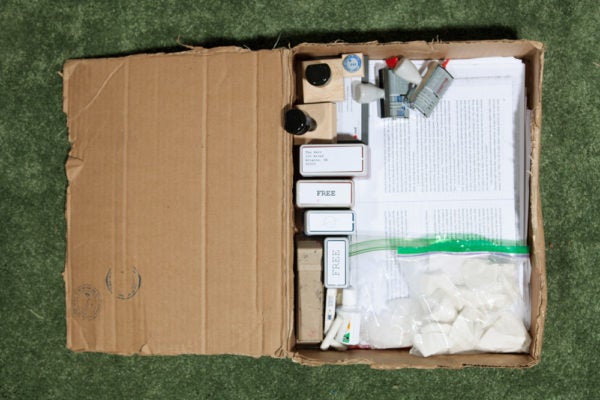
A few days after our conversation at the Majestic, I attended musical/sound performances by Taylor Janay Manigoult and Elaine Edenfield at The Zero, where attendees were each given their own manila folder of artifacts to take home. Mine included a photograph of the locked, grated metal front door of the downtown DIY space Murmur.
Catherine Rush: You were introduced over email by curator Daniel Fuller, but when did the two of you first meet in person?
Blair LeBlanc: I saw Mo’s work while I was working at the Art Papers auction earlier this year and realized I’d been thinking about her for a while, so I just texted her to see if she would meet me and look at a movie I was working on at the time. We met up at Ebrik downtown and started talking and working on things. It was just so great.
CR: What was the film?
BL: It’s a movie called Perrin, and it’s a portrait of my friend, the artist Perrin Turner. In this movie, I’m staring at him with a camera for an hour and a half as he’s playing Cards Against Humanity. It was scored by my friend Louis Johnson, who lives here in Atlanta, who watched the footage and played bass in reaction to Perrin’s movements.
Mo Costello: At our café meeting, Blair generously showed it to me. I’m a little shy and awkward, among other things, and I have a tendency to want desperately to say yes when people invite me to collaborate, but I usually say no because I get scared or something. And this time I said yes spontaneously because the message was so spontaneous, and I didn’t know who it was from—it was from an unidentified number. I was really grateful for it.
I think something I long for endlessly is some kind of dialogue that feels generative and playful and in a way that I certainly relate to childhood, or maybe adolescence more so, when socialization has a structure. For me, the most exciting ways of working are with other people. I work on my own too, but I find that when I’m making something with somebody else, it’s like, I don’t want to sleep! All I want to do is draw and make and plan and unplan.
CR: Because you have someone holding you accountable?
MC: Yes, in a way that is mystical to me; it’s everything. I’ve spent time, say, in the context of the university, and in these spaces, well, there are conditions. They can be one thing or they can be another thing. But often the conditions are such that they become regulatory, and not generative and not generous and not supportive. Or, if the conditions are such, there can be space for enthusiasm and for joy and for giving and for challenging with some sense of collective mission, right? To get somewhere together.
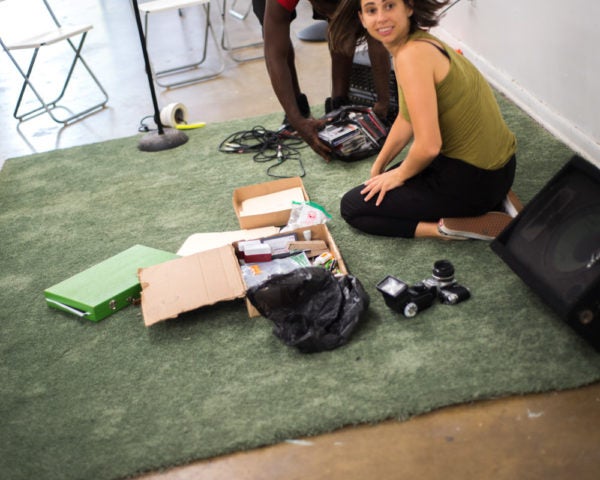
CR: What is The Zero? How did it come about?
MC: It’s fun to think about origin, make up origin, recreate origin. I love going to Murmur, and I always told [Murmur director] Brandon [Sheats], “Anytime you need help, or want someone to bartend, or whatever, I’d give an arm and a leg to do it.” And intuitively, I was like, “Oh my god, I know the only other person who would want to do this—for free—is Blair.” And they said yes.
BL: We did a show right at the same time when the DIY spaces on Broad Street were shut down.
CR: After the fire earlier this year?
BL: Yeah, a week or two after that happened. And so the street was particularly dead: that loss was really felt on Broad Street. It was Atlanta’s hub for DIY music and art. After that show happened, we started talking to Brandon about the possibility of using the space, and something Mo and I had discussed very deeply is education.
Mo’s taught classes at UGA, among other places, and I’m obsessed with school. School is where I became an artist and found photography in a really exciting way, because there was a community there that I hadn’t felt before. So through a bunch of conversations and different emails, we talked about making some sort of structured programming and calling it a school, and it being something that resembled what our ideal school structure would be like.
For this first semester, there are these two-act shows: two artists, musicians, performative acts. We’re also doing a series of lectures by artists speaking about other artists they’re in love with called “Who Do You Love.” Those have been so fucking incredible. In our most recent one, Debra Beat presented on the heavy metal musician Rob Halford. She dressed up as Rob Halford and played a Judas Priest song as part of her lecture. Debra has a tattoo of one of their albums on her leg.
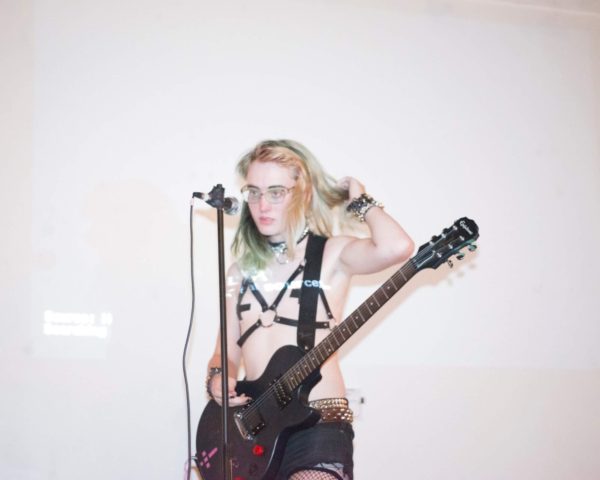
CR: What’s the next lecture?
BL: The next lecture is going to be Taylor Alxndr on October 7. They’ll be speaking about Santigold, one of their favorite musicians. Taylor is a super cool artist and musician and the organizer of Southern Fried Queer Pride in Atlanta. We definitely wanted to have people involved who are doing things in Atlanta, and just have them do something fun. A lot of this is just motivated by feeling like wanting to build a community of femme queer artists specifically.
MC: I think it’s maybe helpful to think about playing school. There are these pedagogical forms that we know, or we’ve learned, and in playing with them, re-enacting them, and performing them, we can shift them, and move them around a little bit. What is a lecture? What can a lecture be? What is a class? What can a class be? What is an assignment? What do these things look like? I want to understand them as things that are constantly shifting, changing, and shrinking—growing in really weird ways that are only possible outside of an institution. I want a space where we get to play, we get to make things up, we get to use the structure of the lecture to bring together people. That’s primary.
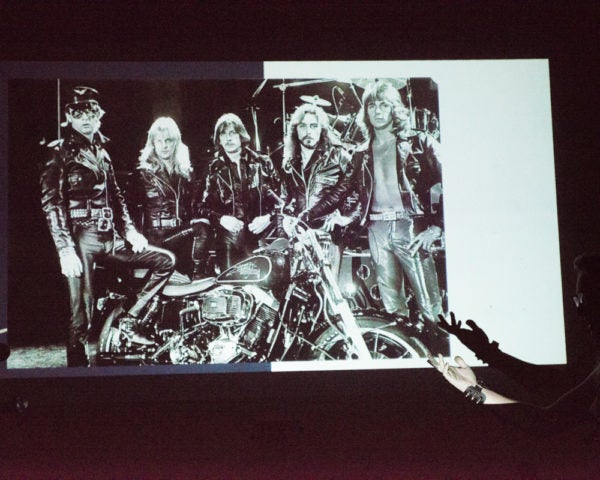
One thing I love about it that Blair spoke to is that everyone’s instructors, everyone’s professors, everyone’s students. I want to ensure a balance between structure—which is so important, because it creates space for connection and contact; it’s an invitation—but not so much structure that you lose the magic which is that which is already happening, which is fucking Broad Street, which is Murmur, which is the wildness of convergences that happen among strangers in these spaces. Instead of a school being a place where information is transmitted, what if it was about creating conditions that are conducive to inquiry, awareness, love, challenge, and support? These things aren’t about knowledge being transmitted; they’re about a place where it’s safer to make, you know?
CR: What are your ultimate hopes for this project? You mentioned creating the “ideal school,” if you want to expand on that.
MC: I would challenge that. Maybe this is counterintuitive, but what is a school that’s made up of failure? The notion of an ideal is difficult to me, because I’ve spent so much time in spaces where the emphasis is placed on that which is to come. I think there’s something important about returning to a space of failure and messiness. And that’s not to not have those dreams, because I think there’s a profound place for those. At The Zero, we’ll constantly be creating dreams or shapes or possibilities—it’ll keep shifting.
BL: Definitely.
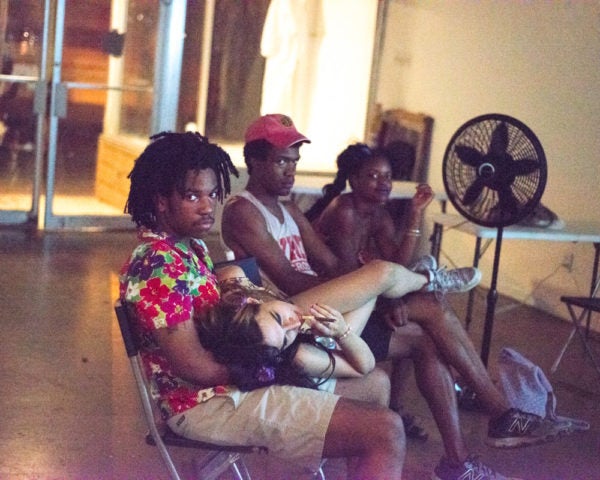
MC: Because it’s not about controlling the outcome: it’s that there’s some kind of invitation for participation, and then shape is made. We create conditions, and what those conditions allow for we’ve yet to see. Like, at the lecture that just happened, we never could have imagined what shape that would have taken.
BL: Totally. There ended up being karaoke and things that we weren’t thinking of.
MC: It was amazing. Blair and I are endlessly sharing texts, and one text I shared with them was The Undercommons by Stefano Harney and Fred Moten. In these essays, they talk about the university as instructors within institutions, how they imagine that it’s a place for refuge, but in fact it’s not—and it can be—but one of the things Moten asks is, “What happens if you don’t call the class to order?” What if you trust the magic of what’s already happening? You just create a space for it to happen. And you trust the brilliance of Taylor Alxndr, you trust the brilliance of Elaine [Edenfield], you trust the brilliance of these individuals, and you’re quietly digging a hole, or making a nest, or building a little space for some magic to happen.
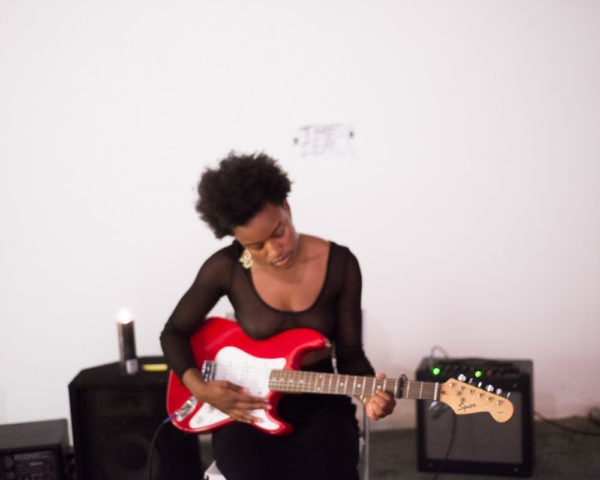
BL: I love that it’s something that is, in a way, endless. It’s so fun to plan for a semester and then see what happens, then move on from there. In the traditional understanding of studying, the entire goal is to get out of the university. I would love to do this forever.
MC: The first text we shared was Cixous, and there’s that line, “There’s no end, only time will put an end to it.” It’s about drawing: drawing as a way of thinking, drawing as process, drawing as writing. And I think the idea of drawing a school is helpful. Because it’s this kind of, like, sketching.
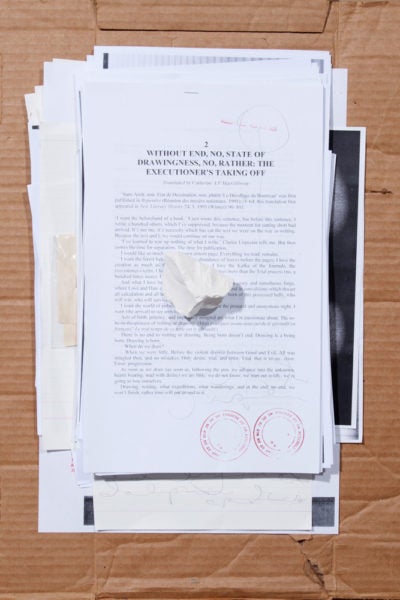
CR: Why did you choose the name The Zero?
BL: I was actually driving in my car, and I was thinking about what we should call whatever the fuck me and Mo are doing. I was thinking that it shouldn’t be called anything at all, but I still wanted it to have a name.
MC: And that’s why Blair is so good, because I’m constantly like, no name, no; no definition, no rules, we don’t tell anybody what it’s about, it’s a secret. And Blair’s like, “Mo, you have to have a name.”
BL: So after thinking through that and sitting on it for a minute I thought, The Zero. And so I googled “The Zero,” which is usually the first thing that I do when I’m thinking about something: just google it and read the Wikipedia page. The number zero is beautiful. It’s a relatively new number.
MC: It’s kind of a mythic number, right?
BL: Right, exactly. In Ancient Egypt, the symbol for zero also meant beautiful. It quite literally is a starting place from which other things go, and that’s one thing that I’m always craving: just a place to start. Because so often I feel like there’s a lot that needs to happen retrospectively. I need to go back and I need to archive and find all the artists that have been lost to history or lost to Moloch and these other institutions, or who just were forgotten about. And so I loved that about the number zero. I love that a zero has this a-ha sound in it, like zer-o. It means a lot of things. Not far from the Murmur space, under the Central Avenue viaduct in between Alabama and Wall streets, is the Zero Milepost, the center of Atlanta.
MC: No way.
BL: Yeah.
MC: When Blair first proposed the title, it was like, “Oh yeah, of course, duh.” I am constantly craving celebration of that which isn’t, to the dismay of everyone around me, I think. Like, nobody can read my handwriting; nobody has any idea what I’m talking about like half of the time. So there’s something about zero that’s like, nuh-uh. There’s an evasion there that I kinda love. It’s in-between. Like it ain’t negative one, and it ain’t one. And it’s round.
BL: Totally, ugh. And it looks like an egg.




